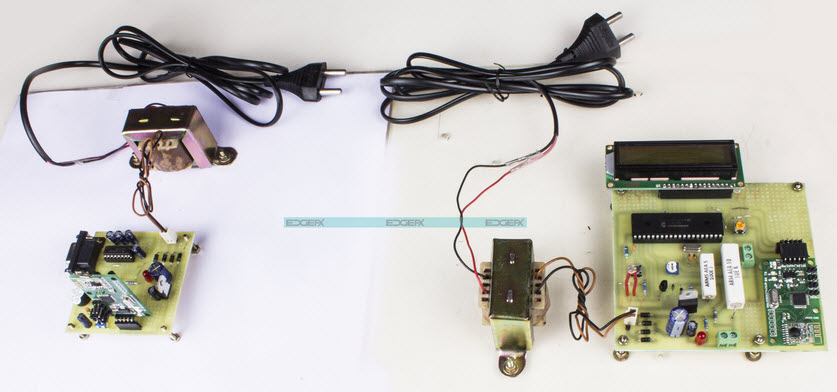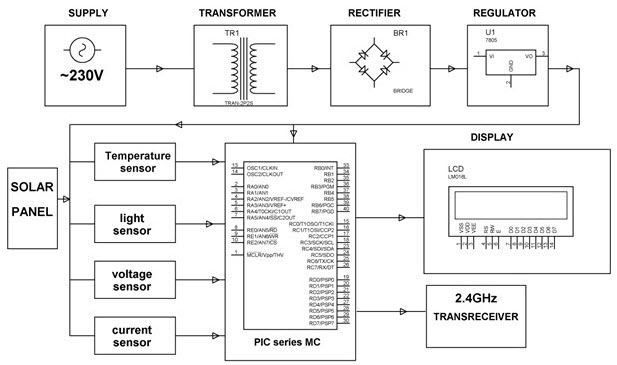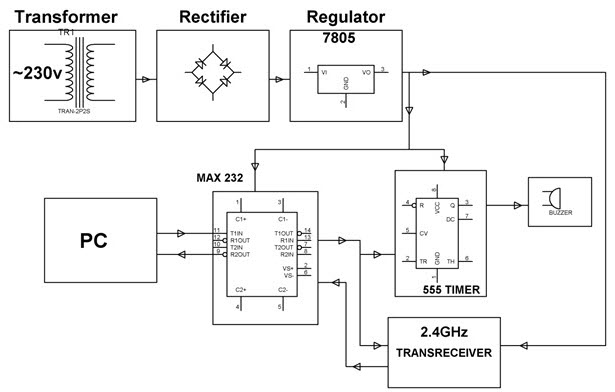In our day-to-day life, we consume
electrical energy for various purposes such as for powering electrical
appliances, gadgets, devices, machines, and so on. So, it is essential
to measure the amount of power consumed to generate electricity bill
which is usually done by energy meters. In general, AC power is measured
using various techniques, here in this article let us discuss about AC
power measurement meter using PIC microcontroller.
Power Measurement
The electrical power can be AC power or
DC power, energy meter is used for measuring power. There are various
types of energy meters, which are classified as digital energy meter,
electronic energy meter, watt meter, three phase energy meter, single phase energy meter, AC power measurement meter, and so on.
The AC power is given by the product of
RMS voltage value across the load, RMS current across the load, and
power factor of the load. This can be represented as shown in the
equation below.
Now, AC power measurement can be defined as the measurement of
voltage, measurement of current, and measurement of power factor. So, to
measure power consumption using PIC microcontroller, it is essential to
measure voltage using PIC microcontroller, measure current using PIC
microcontroller, and measure power factor using PIC microcontroller.AC Voltage Measurement using PIC Microcontroller
The microcontrollers generally operated
and manufactured to work with voltage ratings less than or equal to 5V.
So, it is not possible to directly measure AC voltage greater than 230V
by giving high input voltages to microcontrollers which may cause
temporary or permanent damage to microcontrollers.
Hence, it is required to step down the
high AC voltage around 230V to 5V for measuring voltage using
microcontrollers. The AC voltage measurement using PIC microcontroller
can be done using a difference amplifier
or potential transformer. The difference amplifier or potential
transformer is used to step-down the voltage and then by using analog to
digital converter or rectifier the voltage reading is displayed on LCD
display.
AC Current Measurement using PIC Microcontroller
The PIC microcontroller can be used for measuring AC current with the help of difference amplifier, shunt resistor, and analog to digital converter.
Shunt resistors are used as transducers for converting current into
voltage as microcontroller directly can not read current. Thus, the
voltage across the shunt resistor can be measured using PIC
microcontroller which is again converted into current using Ohm’s law.
Thus, the measured AC current is displayed on LCD display.
Power Factor Measurement using PIC Microcontroller
The inductor & capacitor cause
lagging & leading power factor, current lags voltage by some angle
& current leads voltage by some angle respectively. Thus, power
factor can be defined as the cosine of the angle between current and
voltage and is given as
To measure power factor using PIC
microcontroller, the time difference between the voltage and current is
determined using zero crossing detection with the help of a
microcontroller external interrupt pin. The interrupt is generated by
whenever voltage waveform’s zero crossing is detected and internal timer
of microcontroller is used for measuring time. Similarly, whenever
current waveform interrupt is generated, then the timer stops counting
and thus time difference is calculated.
This process repeated for a number of
times (say 20 to 30) and the average value is taken for better results.
Hence, the time difference is used to determine the phase angle
difference between voltage and current. Thus, power factor can be
calculated using PIC microcontroller.
Now, by substituting the values of
voltage, current, power factor in the above power equation we can
measure AC power. The meter used for measuring power factor can be
called as power factor meter.
Solar Energy Measurement System Conveyed over RF using a PIC Microcontroller
The main aim of this project is solar energy measurement
using multiple sensor data acquisition. The project utilizes a solar
panel that changes its direction according to sunlight. The solar panel
parameters such as intensity of light, temperature, voltage, and current
are monitored and also sent to PC using RF.
The project block diagram shown in the above figure consists of various blocks, including solar panel, temperature sensor, light sensor, voltage sensor and current sensor
interfaced with the PIC microcontroller. The sensors are used for
measuring temperature, light, voltage, and current and is sent to the PC
using RF, the same data is displayed over the LCD display.
The power supply block, RF transceiver, PC, max232, 555 timer,
and buzzer blocks are connected as shown in the above block diagram.
The solar energy measurement can be achieved by measuring the factors
such as temperature and light intensity that affect energy generation.
There are various types of meters that
include power factor meter, digital energy meter, electronic energy
meter, three phase power measurement, energy meter reading over internet, prepaid energy meter with GSM interface, programmable energy meter for electrical load survey.
Are you interested in designing electronics projects
using the PIC microcontroller? Then, post your queries or ideas in the
comments section below for technical help regarding project solutions.






No comments:
Post a Comment